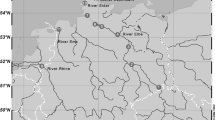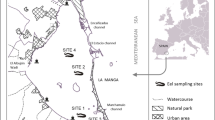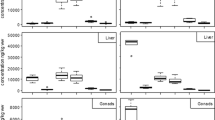Abstract
In conjunction with habitat loss and overfishing, pollution and parasitism are believed to be relevant causes of collapse of Anguilla, as these can affect eel swimming ability and the development of gonads and embryos. The present study investigated Persistent Organic Pollutant (POP) concentrations, infection levels of Anguillicoloides crassus, lipid content and gonad abnormalities in eels sampled in 2007–2008 in three Italian water bodies (Caprolace Lake, Lesina Lagoon and Tevere River) that vary in salinity, trophic condition, contamination level and fishing pressure. Our analysis revealed that low-to-moderate levels of contamination and parasitism were not associated with gonad abnormalities in Caprolace Lake and Lesina Lagoon. On the contrary, POP concentrations and abundances of swim bladder nematodes were remarkably high in eels from the heavily urbanized Tevere River and were associated with significant gonad and swim bladder alterations. Contamination and infestation levels were so high to potentially impair spawner successful migration and reproduction. POP concentrations in Tevere eels also exceeded levels considered safe for food consumption. Though marginally contaminated, eels from the oligotrophic Caprolace Lake were in critical health condition: their lipid reserve was so low as to be considered insufficient to sustain the energetic costs of the transoceanic migration. Lesina eel stock was the only one displaying relatively good quality but here spawner abundance is likely limited by overfishing. Our results suggest that multiple stressors may potentially affect eel reproductive success. More definitive studies are needed to assess whether health effects caused by these multiple stressors are additive, compensatory or synergistic.




Similar content being viewed by others
References
ASL RME (2008) ASL Roma E Dipartimento di Epidemiologia Relazione Conclusiva del 26 Novembre 2008 nell’ambito del progetto “Salute della popolazione nell’area della Valle del Sacco” DOCUP Obiettivo 2 Lazio 2000-2006, Misura I.4. “Azioni di controllo, monitoraggio e informazione ambientale”, pp 79
Bayley M, Junge M, Baatrup E (2002) Exposure of juvenile guppies to three antiandrogens causes demasculinization and a reduced sperm count in adult males. Aquat Toxicol 56:227–239
Belpaire C, Goemans G (2007) The European eel Anguilla anguilla, a rapporteur of the chemical status for the Water Framework Directive? Vie Milieu 57(4):235–252
Belpaire C, Goemans G, Geeraerts C, Quataert P, Parmentier K, Hagel P, De Boer J (2009) Decreasing eel stocks: survival of the fattest? Ecol Freshw Fish 18:197–214
Belpaire C, Geeraerts C, Evans D, Ciccotti E, Poole R (2011a) The European eel quality database: towards a pan-European monitoring of eel quality. Environ Monit Assess 183:273–284
Belpaire C, Geeraerts C, Roosens L, Neels H, Covaci A (2011b) What can we learn from monitoring PCBs in the European eel? A Belgian experience. Environ Int 37(2):354–364
Bettinetti R, Galassi S, Quadroni S, Volta P, Ciccotti E, Capoccioni F, De Leo GA (2011) Use of Anguilla anguilla for biomonitoring Persistent Organic Pollutants (POP) in brackish and riverine waters in Central and Southern Italy. Water Air Soil Pollut 217:321–331
Boetius I, Boetius J (1980) Experimental maturation of female silver eels, Anguilla anguilla. Estimates of fecundity and energy reserves for migration and spawning. Dana 1:1–28
Bordajandi LR, Gòmez G, Fernàndez MA, Abad E, Rivera J, Gonzàlez MJ (2003) Study on PCBs, PCDD/Fs, organochlorine pesticides, heavy metals and arsenic content in freshwater fish species from the River Turia (Spain). Chemosphere 53:163–171
Boscher A, Gobert S, Guignard C, Ziebel J, L’Hoste L, Gutleb AC, Cauchie H-M, Hoffmann L, Schmidt G (2010) Chemical contaminants in fish species from rivers in the North of Luxembourg: potential impact on the Eurasian otter (Lutra lutra). Chemosphere 78:785–792
Bressa G, Sisti E, Cima F (1997) PCBs and organochlorinated pesticides in eel (Anguilla anguilla L.) from the Po delta. Mar Chem 58:261–266
Buet A, Banas D, Vollaire Y, Coulet E, Roche H (2006) Biomarker responses in European eel (Anguilla anguilla) exposed to persistent organic pollutants. A field study in the Vaccarès Lagoon (Camargue, France). Chemosphere 65(10):1846–1858
Bush AO, Lafferty KD, Lotz JM, Shostak AW (1997) Parasitology meets ecology on its own terms: Margolis et al. revisited. J Parasitol 83(4):575–583
Cairns DK, Secor DA, Morrison WE, Hallett JA (2009) Salinity-linked growth in anguillid eels and the paradox of temperate-zone catadromy. J Fish Biol 74(9):2094–2114
Carlson DB, Curtis LR, Williams DE (2000) Salmonid sexual development is not consistently altered by embryonic exposure to endocrine-active chemicals. Environ Health Persp 108:249–255
CITES (2007) Convention on international trade in endangered species of wild fauna and flora. Consideration of proposals for amendment of appendices I and II. Fourteenth meeting of the Conference of the Parties, The Hague (Netherlands), 3–15 June 2007, pp 39
Colombo G, Grandi G (1995) Sex differentiation in the European eel: histological analysis of the effects of sex steroids on the gonad. J Fish Biol 47:394–413
Colombo G, Grandi G (1996) Histological study of the development and sex differentiation of the gonad in the European eel. J Fish Biol 48:493–512
Colombo G, Grandi G, Rossi R (1984) Gonad differentiation and body growth in Anguilla anguilla L. J Fish Biol 24:215–228
Corsi I, Mariottini M, Badesso A, Caruso T, Borghesi N, Bonacci S, Iacocca A, Focardi S (2005) Contamination and sub-lethal toxicological effects of persistent organic pollutants in the European eel (Anguilla anguilla) in the Orbetello Lagoon (Tuscany, Italy). Hydrobiologia 550:237–249
De Charleroy D, Thomas K, Belpaire C, Ollevier F (1989) The viability of the free living larvae of Anguillicola crassus. J Appl Ichthyol 5:154–156
Dekker W (2003) Did lack of spawners cause the collapse of the European eel, Anguilla anguilla? Fish Manag Ecol 10:365–376
DM 22/1/1998. Decreto Ministeriale 22 gennaio 1998. Limiti massimi di residui di sostanze attive dei prodotti fitosanitari tollerate nei prodotti destinati all’alimentazione. Gazzetta Ufficiale n. 78 del 3.04.1998
Durif C, Dufour S, Elie P (2005) The silvering process of Anguilla anguilla: a new classification from the yellow resident to the silver migrating stage. J Fish Biol 66:1025–1043
EC (2007) European Council Regulation (EC) No 1100/2007 of 18 September 2007 establishing measures for the recovery of the stock of European eel. Official Journal of the European Union L248/17-23 of 22.9.2007
Edeline E, Elie P (2004) Is salinity choice related to growth in juvenile eel Anguilla anguilla? Cybium 28(1) suppl.:77–82
Eira C, Torres J, Miquel J, Vaqueiro J, Soares AMVM, Vingada G (2009) Trace element concentrations in Proteocephalus macrocephalus (Cestoda) and Anguillicola crassus (Nematoda) in comparison to their fish host, Anguilla anguilla in Ria de Aveiro, Portugal. Sci Total Environ 407:991–998
Esteve C, Alcaide E (2009) Influence of diseases on the wild eel stock: the case of Albufera Lake. Aquaculture 289:143–149
EU (2011) Commission Regulation (EU) No 1259/2011 of 2 December 2011 amending Regulation (EC) No 1881/2006 as regards maximum levels for dioxins, dioxin-like PCBs and non dioxin-like PCBs in foodstuffs. Official Journal of the European Union L320/18-23 of 3.12.2011
Ferrante MC, Clausi MT, Meli R, Fusco G, Naccari C, Lucisano A (2010) Polychlorinated biphenyls and organochlorine pesticides in European eel (Anguilla anguilla) from the Garigliano River (Campania region, Italy). Chemosphere 78:709–716
Feunteun E (2002) Management and restoration of European eel population (Anguilla anguilla): an impossible bargain. Ecol Eng 18:575–591
Foster EP, Fitzpatrick MS, Feist GW, Schreck CB, Yates J, Spitsbergen JM, Heidel JR (2001) Plasma androgen correlation, EROD induction, reduced condition factor, and the occurrence of organochlorine pollutants in reproductively immature white sturgeon (Acipenser transmontanus) from the Columbia River, USA. Arch Environ Contam Toxicol 41:182–191
Fox K, Zauke G, Butte W (1994) Kinetics of bioconcentration and clearance of 28 polychlorinated biphenyl congeners in zebrafish (Brachydanio rerio). Ecotoxicol Environ Safe 28:99–109
Freyhof J, Kottelat M (2008) Anguilla anguilla. In: IUCN 2008. 2008 IUCN Red List of Threatened Species. http://www.iucnredlist.org. Accessed 23 May 2010
Galassi S, Gandolfi G, Pacchetti G (1981) Chlorinated hydrocarbons in fish from the River Po (Italy). Sci Total Environ 20:231–240
Gargouri Ben Abdallah L, Maamouria F (2006) Spatio-temporal dynamics of the nematode Anguillicola crassus in Northeast Tunisian lagoons. C R Biol 329(10):785–789
Geeraerts C, Belpaire C (2010) The effects of contaminants in European eel: a review. Ecotoxicology 19(2):239–266
Genc E, Sahan A, Altun T, Cengizler I, Nevsat E (2005) Occurrence of the swim bladder parasite Anguillicola crassus (Nematoda, Dracunculoidea) in European eels (Anguilla anguilla) in Ceyhan River, Turkey. Turk J Vet Anim Sci 29(3):661–663
Grandi G, Colombo G (1997) Development and early differentiation of gonad in the European eel (Anguilla anguilla L., Anguilliformes, Teleostei): a cytological and ultrastructural study. J Morphol 231:195–216
Grandi G, Poerio F, Colombo G, Chicca M (2000) Effects of diet supplementation ovary on gonad differentiation and growth of the European eel. J Fish Biol 57:1505–1525
GLWQA, Great Lakes Water Quality Agreement (1987) www.cananglass.org. Accessed on 29 June 2011
Harrad S, Smith D (1999) Eel consumption as a pathway of human exposure to PCBs. Int J Environ Health Res 9:31–37
ICES (2001) Report of the 2000 Session of the Joint EIFAC/ICES Working Group on Eels (WGEEL), 28 August–1 September 2000, St.Andrews, N.B., Canada. ICES CM 2001/ACFM:03. pp 87
ICES (2007) Report of the 2007 Session of the Joint EIFAC/ICES Working Group on Eels (WGEEL), 3–7 September 2007, Bordeaux, France. EIFAC Occasional Paper. No. 38, ICES CM 2007/ACFM:23. pp 526
ICES (2009) Report of the 2009 Session of the Joint EIFAC/ICES Working Group on Eels (WGEEL), 7–12 September 2009, Göteborg, Sweden. ICES CM 2009/ACOM:15. pp 137
ICES (2011) Report of the 2011 Session of the Joint EIFAC/ICES Working Group on Eels (WGEEL), 5–9 September 2011, Lisbon, Portugal. ICES CM 2011/ACOM:18. pp 228
Kelce WR, Stone CR, Laws SC, Gray LE, Kemppainen JA, Wilson EM (1995) Persistent DDT metabolite pp′DDE is a potent androgen receptor antagonist. Nature 375:581–585
Kelly CE, Kennedy CR, Brown JA (2000) Physiological status of wild European eels (Anguilla anguilla) infected with the parasitic nematode, Anguillicola crassus. Parasitology 120:195–202
Kirk RS, Lewis JW, Kennedy CR (2000) Survival and transmission of Anguillicola crassus Kuwahara, Niimi & Itagaki 1974 (Nematoda) in seawater eels. Parasitology 120:289–295
Kruuk H, Conroy JWH (1996) Concentrations of some organochlorines in otters (Lutra lutra L.) in Scotland: implications for populations. Environ Pollut 92:165–171
Larsson P, Hamrin S, Okla L (1990) Fat content as a factor inducing migratory behaviour in the eel (Anguilla anguilla) to the Sargasso Sea. Naturwissenschaften 77(10):488–490
Larsson P, Hamrin S, Okla L (1991) Factors determining the uptake of persistent pollutants in an eel population (Anguilla anguilla L.). Environ Pollut 69:39–50
Lawrence AJ, Elliot M (2003) Introduction and conceptual model. In: Lawrence A, Hemingway K (eds) Effects of pollution on fish: molecular effects and population responses. Blackwell Science Ltd, Oxford, pp 1–13
Lefebvre F, Crivelli AJ (2004) Anguillicolosis: dynamics of the infection over two decades. Dis Aquat Organ 62:227–232
Lefebvre F, Contournet P, Priour F, Soulas O, Crivelli AJ (2002) Spatial and temporal variation in Anguillicola crassus counts: results of a 4-year survey in eels from Mediterranean lagoons. Dis Aquat Organ 50:181–188
Lefebvre F, Acou A, Poizat G, Crivelli AJ (2003) Anguillicolosis among silver eels: a 2-year survey in 4 habitats from Camargue (Rhône delta, South of France). B Fr Pêche Piscic 368:97–108
Lefebvre F, Fazio G, Palstra AP, Szèkely C, Crivelli AJ (2011) An evaluation of indices of gross pathology associated with the nematode Anguillicoloides crassus in eels. J Fish Dis 34:31–45
Louiz I, Ben-Attia M, Ben-Hassine OK (2009) Gonadosomatic index and gonad histopathology of Gobius niger (Gobiidea, Teleost) from Bizerta Lagoon (Tunisia): evidence of reproduction disturbance. Fish Res 100:266–273
Maamouria F, Gargouri L, Ould Daddah M, Bouix G (1999) Occurrence of Anguillicola crassus (Nematode, Anguillicolidae) in the Ichkeul Lake (northeastern Tunisia). Bull Eur Assoc Fish Pathol 19:17–19
Macgregor K, Oliver IW, Harris L, Ridgway IM (2010) Persistent organic pollutants (PCB, DDT, HCH, HCB & BDE) in eels (Anguilla anguilla) in Scotland: current levels and temporal trends. Environ Pollut 158:2402–2411
Machut LS, Limburg KE (2008) Anguillicola crassus infection in Anguilla rostrata from small tributaries of the Hudson River watershed, New York, USA. Dis Aquat Organ 79:37–45
Maes J, Belpaire C, Goemans G (2008) Spatial variations and temporal trends between 1994 and 2005 in polychlorinated biphenyls, organochlorine pesticides and heavy metals in European eel (Anguilla anguilla L.) in Flanders, Belgium. Environ Pollut 153:223–237
Maillo PA, Vich MA, Salvado H, Marques A, Gracia MP (2005) Parasites of Anguilla anguilla (L.) from three coastal lagoons of the River Ebro delta (Western Mediterranean). Acta Parasitol 50(2):156–160
Mariottini M, Corsi I, Focardi S (2006) PCB levels in European eel (Anguilla anguilla) from two coastal lagoons of the Mediterranean. Environ Monit Assess 117:519–528
Matthiessen P (2003) Endocrine disruption in marine fish. Pure Appl Chem 75(11–12):2249–2261
Miller WR, Sharpe RM (1998) Environmental estrogens and human reproductive cancers. Endocr Relat Cancer 5:69–96
Miniero R, Guandalini E, Dellatte E, Iacovella N, Abate V, De Luca S, Iamiceli AL, di Domenico A, De Felip E (2011) Persistent Organic Pollutants (POPs) in fish collected from the urban tract of the River Tiber in Rome (Italy). Annali dell’Istituto Superiore di Sanità 47(3):310–315
Möller H, Holst S, Lüchtenberg H, Petersen F (1991) Infection of eel Anguilla anguilla from the River Elbe estuary with two nematodes, Anguillicola crassus and Pseudoterranova decipiens. Dis Aquat Organ 11(3):193–199
Nash RDM, Valencia AH, Geffen AJ (2006) The origin of Fulton’s condition factor—setting the record straight. Fisheries 31(5):236–238
OM 18/07/1990. Ordinanza Ministeriale del 18/07/1990. G.U. della Repubblica Italiana No. 57 del 30.08.1990
Palstra AP, van Ginneken VJT, Murk AJ, van den Thillart GEEJM (2006) Are dioxin-like contaminants responsible for the eel (Anguilla anguilla) drama? Naturwissenschaften 93:145–148
Palstra AP, Heppener DFM, van Ginneken VJT, Székely C, van den Thillart GEEJM (2007) Swimming performance of silver eels is severely impaired by the swim bladder parasite Anguillicola crassus. J Exp Mar Biol Ecol 352:244–256
Pankhurst NW (1982) Relation of visual changes to the onset of sexual maturation in the European eel A. anguilla (L.). J Fish Biol 21:127–140
Rahhou I, Melhaoui M, Lecomte-Finiger R, Morand S, Chergui H (2001) Abundance and distribution of Anguillicola crassus (Nematoda) in eels Anguilla anguilla from Moulouya Estuary (Morocco). Helminthologia 38(2):93–97
Robinet T, Feunteun E (2002) Sublethal effects of exposure to chemical compounds: a cause for the decline in Atlantic Eels? Ecotoxicology 11:265–277
Sjoberg NB, Petersson E, Wickstrom H, Hansson S (2009) Effects of the swim bladder parasite Anguillicola crassus on the migration of European silver eels Anguilla anguilla in the Baltic Sea. J Fish Biol 74:2158–2170
Storelli MM, Barone G, Garofalo R, Marcotrigiano GO (2007) Metals and organochlorine compounds in eel (Anguilla anguilla) from the Lesina Lagoon, Adriatic Sea (Italy). Food Chem 100:1337–1341
Sures B (2006) How parasitism and pollution affect the physiological homeostasis of aquatic hosts. J Helminthol 80(2):151–157
Sures B, Knopf K (2004) Individual and combined effects of cadmium and 3,3′,4,4′,5-pentachlorobiphenyl (PCB126) on the humoral immune response in European eel (Anguilla anguilla) experimentally infected with larvae of Anguillicola crassus (Nematoda). Parasitology 128:445–454
Sures B, Knopf K, Kloas W (2001) Induction of stress by the swim bladder nematode Anguillicola crassus in European eels, Anguilla anguilla, after repeated experimental infection. Parasitology 123(2):179–184
Sures B, Lutz I, Kloas W (2006) Effects of infection with Anguillicola crassus and simultaneous exposure with Cd and 3,3′,4,4′,5-pentachlorobiphenyl (PCB 126) on the levels of cortisol and glucose in European eel (Anguilla anguilla). Parasitology 132:281–288
Svobodová Z, Žlábek V, Randák T, Máchová J, Kolářová J, Hajšlová J, Suchan P (2003) Profiles of Persistent Organochlorine Pollutants (POPs) in tissues of marketable common carp and in bottom sediment of selected ponds of South and West Bohemia. Acta Vet Brno 72:295–309
Székely CS, Molnár K, Rácz O (2005) Radiodiagnostic method for studying the dynamics of Anguillicola crassus (Nematoda: Dracunculoidea) infection and pathological status of the swim bladder in Lake Balaton eels. Dis Aquat Organ 64(1):53–61
Tenora F, Barus V, Kracmar S, Dvoracek J, Srnkova J (1999) Parallel analysis of some heavy metals concentrations in the Anguillicola crassus (Nematoda) and the European eel Anguilla anguilla (Osteichthyes). Helminthologia 36(2):79–81
Tesch FW (2003) In: Thorpe JE (ed) The eel, vol 65, 3rd ed. Blackwell Science Ltd, Oxford
van den Berg M, Birnbaum LS, Denison M, De Vito M, Farland W, Feeley M, Fiedler H, Hakansson H, Hanberg A, Haws L, Rose M, Safe S, Schrenk D, Tohyama C, Tritscher A, Tuomisto J, Tysklind M, Walker N, Peterson RE (2006) The 2005 World Health Organization reevaluation of human and mammalian toxic equivalency factors for dioxins and dioxin-like compounds. Toxicol Sci 93:223–241
van den Thillart G, van Ginneken V, Körner F, Heijmans R, van der Linden R, Gluvers A (2004) Endurance swimming of European eel. J Fish Biol 65:1–7
Vethaak AD, Reinhalt T (1992) Fish disease as a monitor for marine pollution: the case of the North Sea. Rev Fish Biol Fish 2:1–32
Zhang Z, Hu J (2008) Effects of p,p-DDE exposure on gonadal development and gene expression in Japanese medaka (Oryzias latipes). J Environ Sci 20:347–352
Acknowledgments
This work was supported by the Italian Ministry of University and Scientific Research—PRIN Project 2006 (n. 2006054928): “An Integrated Approach to the Conservation and Management of the European Eel in the Mediterranean Region”. Thanks are due to Dr Milvia Chicca (Department of Biology and Evolution, University of Ferrara) for the English revision of the manuscript. The authors are very grateful also to the referees and the associated editor for their constructive criticism and suggestions that helped to greatly improve the paper.
Conflict of interest
The authors declare that they have no conflict of interest.
Author information
Authors and Affiliations
Corresponding author
Electronic supplementary material
Below is the link to the electronic supplementary material.
Rights and permissions
About this article
Cite this article
Quadroni, S., Galassi, S., Capoccioni, F. et al. Contamination, parasitism and condition of Anguilla anguilla in three Italian stocks. Ecotoxicology 22, 94–108 (2013). https://doi.org/10.1007/s10646-012-1006-0
Accepted:
Published:
Issue Date:
DOI: https://doi.org/10.1007/s10646-012-1006-0




